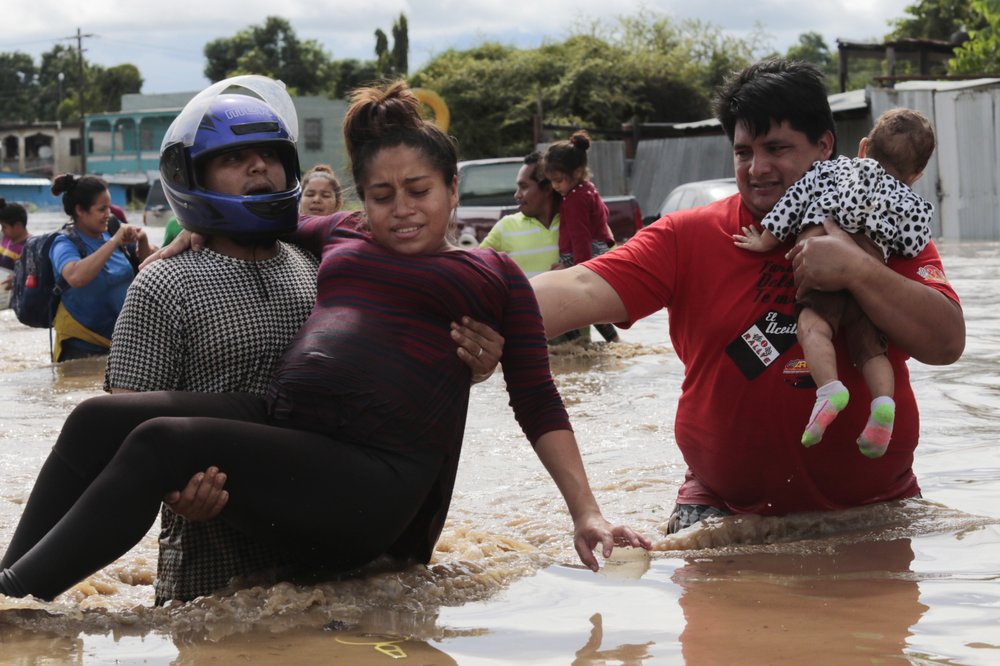A pregnant woman is carried out of an area flooded by water brought by Hurricane Eta in Planeta, Honduras, Thursday, Nov. 5, 2020. The storm that hit Nicaragua as a Category 4 hurricane on Tuesday had become more of a vast tropical rainstorm, but it was advancing so slowly and dumping so much rain that much of Central America remained on high alert. (AP Photo/Delmer Martinez)
MANAGUA, Nicaragua (AP) — Hurricane Iota rapidly strengthened Monday into a Category 5 storm that is likely to bring catastrophic damage to the same part of Central America already battered by a powerful Hurricane Eta less than two weeks ago.
Iota has intensified over the western Caribbean on approach to Nicaragua and Honduras. U.S. Air Force hurricane hunters flew into Iota’s core and measured maximum sustained winds of 160 mph (260 kph), the U.S. National Hurricane Center said. It was centered about 100 miles (160 kilometers) east-southeast of Puerto Cabezas, Nicaragua and moving westward at 9 mph (15 kph).
Authorities warned that Iota would probably come ashore over areas where Eta’s torrential rains saturated the soil, leaving it prone to new landslides and floods, and that the storm surge could reach a shocking 12 to 18 feet (3.6 to 5.5 meters) above normal tides.
Evacuations were being conducted from low-lying areas in Nicaragua and Honduras near their shared border, which appeared to be Iota’s likely landfall. Winds and rain were already being felt on the Nicaraguan coast Sunday night.
Iota became a hurricane early Sunday and rapidly gained more power. It was expected to pass over or near Colombia’s Providencia island during the night, and the U.S. National Hurricane Center warned it would probably reach the Central America mainland late Monday.
The hurricane center said Iota was centered about 20 miles (35 km) off Isla de Providencia, Colombia, and 145 miles (235 km) southeast of Cabo Gracias a Dios on the Nicaragua-Honduras border, and moving westward at 10 mph (17 kph).
Iota is the record 30th named storm of this year’s extraordinarily busy Atlantic hurricane season. It’s also the ninth storm to rapidly intensify this season, a dangerous phenomenon that is happening increasingly more often. Such activity has focused attention on climate change, which scientists say is causing wetter, stronger and more destructive storms.
All of Honduras was on high alert, with compulsory evacuations that began before the weekend. By Sunday evening 63,500 people were reported to be in 379 shelters just in the northern coastal region.
Nicaraguan officials said that by late Sunday afternoon about 1,500 people, nearly half of them children, had been evacuated from low-lying areas in the country’s northeast, including all the inhabitants of Cayo Misquitos. Authorities said 83,000 people in that region were in danger.
Wind and rain were beginning to be felt Sunday night in Bilwi, a coastal Nicaraguan city where people crowded markets and hardware stores during the day in search of plastic sheeting, nails and other materials to reinforce their homes, just as they did when Hurricane Eta hit on Nov. 3.
Several residents of Bilwi expressed concern that their homes would not stand up to Iota, so soon after Eta. Local television showed people being evacuated in wooden boats, carrying young children as well as dogs and chickens.
Eta already wreaked havoc. It hit Nicaragua as a Category 4 hurricane, killing at least 120 people as torrential rains caused flash floods and mudslides in parts of Central America and Mexico. Then it meandered across Cuba, the Florida Keys and around the Gulf of Mexico before slogging ashore again near Cedar Key, Florida, and dashing across Florida and the Carolinas.
Iota was forecast to drop 8 to 16 inches (200-400 millimeters) of rain in northern Nicaragua, Honduras, Guatemala and southern Belize, with as much as 30 inches (750 millimeters) in isolated spots. Costa Rica and Panama could also experience heavy rain and possible flooding, the hurricane center said.
Eta was this year’s 28th named storm, tying the 2005 record. Remnants of Theta, the 29th, dissipated Sunday in the eastern Atlantic Ocean.
Over the past couple of decades, meteorologists have been more worried about storms like Iota that power up much faster than normal. They created an official threshold for this rapid intensification — a storm gaining 35 mph (56 kph) in wind speed in just 24 hours. Iota doubled it.
Earlier this year, Hannah, Laura, Sally, Teddy, Gamma, Delta, Zeta and Iota all rapidly intensified. Laura and Delta tied or set records for rapid intensification.
National Oceanic and Atmospheric Administration climate and hurricane scientists studied the effect and found “a lot of that has to do with human-caused climate change.”
This is the first time on record that the Atlantic had two major hurricanes, with winds exceeding 110 mph (177 kph), in November, with Iota and Eta, according to Colorado State University hurricane researcher Phil Klotzbach. When Iota’s top winds reached 155 mph (250 kph), they tied with 1999’s Lenny for the strongest Atlantic hurricane this late in the calendar year.
The official end of the hurricane season is Nov. 30.
Associated Press writer Marlon González in Tegucigalpa, Honduras, contributed to this report.
Copyright 2020 Associated Press. All rights reserved.


